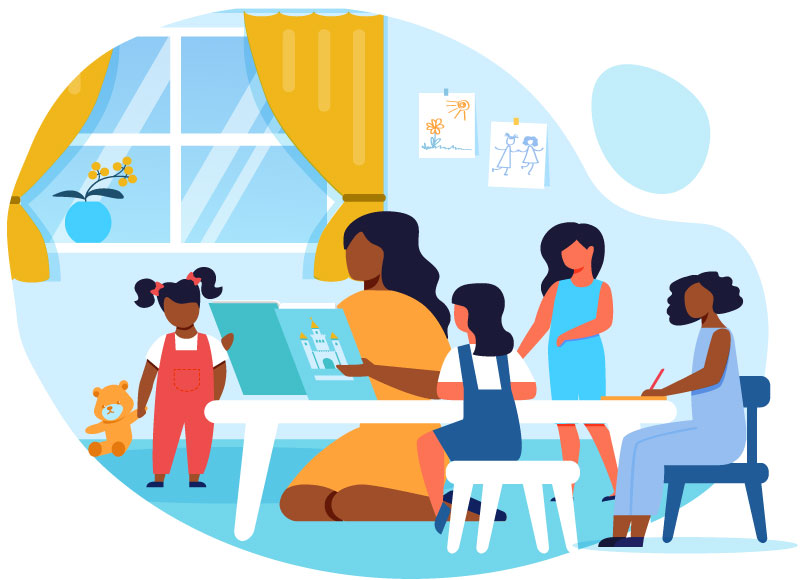Engaging Young People Through Read-Alouds | Donalyn Miller
In quarantine, read-alouds remain a powerful way to engage young readers and support their long-term reading growth.
 |
UnitoneVector/Getty Images |
When schools closed due to the coronavirus pandemic this spring, educators scrambled to provide students with the resources and instructional support needed to continue learning at home. Many school communities took advantage of resources offered by children’s book publishers, authors, and illustrators, including lessons, activities, online text databases and publications, and videos with prerecorded read-alouds.
Because of inadequate funding, community debate, and shifting state and local mandates, many schools are still creating their instructional models for this fall or creating plans in response to multiple scenarios. While moving between online and face-to-face instruction requires shifts, some practices transition better than others. Read-alouds remain a powerful way to engage young readers and support their long-term reading growth.
They also bestow benefits far beyond primary school: Secondary students show reading proficiency gains from regular read-alouds. The International Reading Association emphasizes, “Effective read-alouds increase children’s vocabulary, listening comprehension, story schema, background knowledge, word recognition skills, and cognitive development.” When students encounter a wide variety of texts, voices, and experiences through read-alouds, their social comprehension increases, too (Ahmed, 2018). As you consider three read-aloud benefits, brainstorm ideas for working with families and colleagues to ensure all students experience read-alouds this year.
Three benefits of reading aloud
Read-alouds build community. In my experience, nothing builds community faster than a great read-aloud. Laughing and crying together, connecting to characters and subjects, discussing ideas—read-alouds provide students with academic and social opportunities to interact with texts. These shared experiences foster reader-to-reader relationships and conversations among students. In a classroom of diverse reading abilities and confidence, read-alouds increase access to texts that some students cannot read independently, yet. Shared texts become touchstones students can revisit all year.
Read-alouds introduce young readers to authors, illustrators, genres, formats, and topics. Beyond their value as mentor texts or ability to evoke readers’ response, read-alouds expand students’ schema for the types of texts they might read on their own.
Use interest surveys to identify topics relevant to students. Consider how you will share texts. How will readers view illustrations? How will you scaffold English language learners or students who need reading support? You don’t have to read an entire book aloud every time. Many teachers conduct “First Chapter Fridays”—reading aloud the first chapter of an intriguing book, discussing the text with students, and then offering the book up for borrowing.
Read a short story from an anthology, a few poems, or share a captivating two-page spread. Introduce students to credible, high-quality websites they can use for their own inquiry, such as NASA, Teen Vogue, or Wonderopolis. Read-alouds support students’ ability to self-select texts for independent reading by introducing them to what’s available. If you’re looking for new read-aloud ideas, check out SLJ ’s Best Reads for Summer 2020 series for some recently published, notable titles.
Read-alouds build background knowledge. The pandemic has closed or limited access to museums, zoos, parks and playgrounds, youth centers, and community programs, and many young people have lost enrichment opportunities. These experiences can increase their vocabulary, conceptual knowledge, engagement with self-learning, and understanding of the world. While we cannot replace many hands-on experiences, we can share texts and other media feeding students’ interests, expanding their horizons, and providing information.
Surveying more than 100 elementary school librarians, teachers, and families recently provided some insight into schools’ plans for providing students with reading material and regular read-alouds. Numerous schools are offering families the choice between in-person schooling and online classes at home, so librarians are setting up text databases such as Epic! and Sora, while also creating processes for recommending and circulating print books.
Many schools will continue using resources and platforms they discovered or fine-tuned this spring. Some educators express concern about recording and sharing read-alouds due to copyright laws limiting such activities. Publishers have supported schools with read-aloud resources and fewer restrictions on sharing texts. Check SLJ’s COVID-19 Publisher Information Directory for publishers’ current policies.
Responsive to community disparities in access to print materials and technology, schools are developing systems for distributing books, laptops, Wi-Fi hotspots, and assistive technology to families who need them. Partnerships between public and school libraries to distribute library cards provide more families with access to reading materials and resources, too.
While community needs and resources differ, every school faces challenges to providing equitable learning opportunities for all students during the pandemic. Ensuring access to texts and conducting regular read-alouds belong on any list of considerations as schools develop effective literacy instruction plans. Partner with families to identify needs. Provide books and technology. Record demonstrations of read-alouds, so caregivers and parents have models. Focus on reading enjoyment and family togetherness, not academic reading tasks. Read-alouds communicate pleasure messages about reading and the value of sharing books together. These messages will last long after the pandemic subsides.
RELATED
The job outlook in 2030: Librarians will be in demand
The job outlook in 2030: Librarians will be in demand
ALREADY A SUBSCRIBER? LOG IN
We are currently offering this content for free. Sign up now to activate your personal profile, where you can save articles for future viewing






Add Comment :-
Comment Policy:
Comment should not be empty !!!
Shirley Meyers
This article is so helpful as we try to teach in our new normal. Great tips for helping students advance in their reading skills even in the uncertain times we face.
Posted : Aug 11, 2020 07:52